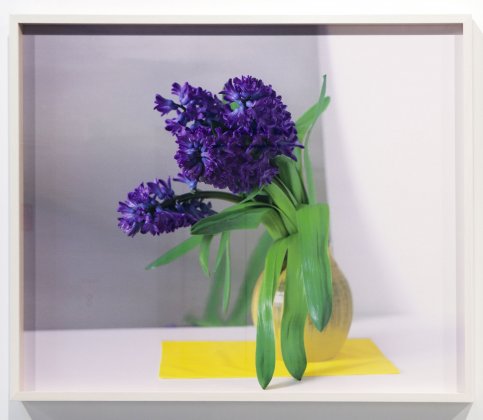14 October – 12 November 2011

Emma White Still life (straight photography) 2011 archival inkjet print on Eterna Elite paper 93 x 113 x 6 cm
Emma White is widely known for her detailed sculptures of everyday objects from her studio. The objects are associated with the process of making, however the activities that they allude to take on an unexpected aura when we realise they are an intricate ruse: laboriously constructed from polymer clay. The Plastic Arts consists of stop motion animation, photographs and objects that have begun a journey away from objective signs and into a space that is about our consumption and interpretation of them.
These works meld photography, painting and sculpture. In moving the expressive possibilities of polymer clay into the realm of painting, the works toy with our reading of shape and form, and we become included in the process of reading their shifting surfaces. She challenges the trust we associate with a completed image, experimenting with the thing and its double, and exposing our need to create order in an amorphous world.
Your work to date has incorporated various forms of simulacra, what position does the abstract work in The Plastic Arts take in relation to representation?
EW. I’ve felt that my work has become so hyper-literal that—although I’ve been interested in and obsessively pursuant of that literalism at times—it was becoming too much of a constraint. In practice, I’ve always been driven by the processes of making, of working out problems through trial and error. I wanted to open up a more flexible space for works that come out of that process. In The Plastic Arts I’m not thinking so much about representation (except inasmuch as photography is always about representation, because of its perceived indexical relationship to reality), rather, I’m thinking about formal pictorial conventions, specifically flatness and dimensionality. I’m interested in representing moments in the process of working with a particular material, moments where it becomes more beautiful, or interesting, in its indeterminacy as pure colour and surface than a finished ‘thing’ would be. In the past, sometimes the material qualities and colours have disappeared under the dominance of the ‘thing’ pictured. I wanted to try and find a way around that by making pictures that aren’t necessarily clearly of something. With this work I’m interested in constructing pictures through an experimental rather than deterministic process. Keeping the experiment within the photographic frame encourages you to think differently about what a photograph can be made from. And there’s a fair amount of re-photography in this work, combining flat and three-dimensional into a single pictorial space.
Photography often occurs in series. Originally I wanted to see if I could have each picture express something different rather than each part be a block in the same construction. But with a series of works, each piece tends to be taken as a word in a sentence as long as they are in the same room together. There are single works in here designed to operate as a kind of punctuation for that sentence; works that tell you that you shouldn’t be entirely sure of what kind of picture you’re looking at, and how it was made. There are also works whose simplicity (‘straightness’) can be construed as a deception. Each picture has to change the series, or its presence is redundant; so some of them exist simply to jar, or change your understanding of their neighbouring pictures. In fact the pictures are simply images of objects in space—every one. In that sense they are all ‘still lives’.
These works have come from a period of experimenting with abstract painting. I was trying to find a way towards abstraction; to have the freedom of making pictures without being tied to representation. This idea I have of abstraction’s freedom is something I feel about painting as well; my practice has felt connected to painting for as long as I’ve been using polymer clay. The only real difference between polymer clay and acrylic paint is their viscosity. Paint needs a surface to adhere to and support it, and polymer clay (once cured) can carry its own weight and manifest itself three-dimensionally with a more obvious kind of objecthood. Both are pigment-carrying media that can be mixed and manipulated into deceptive forms. With this work, rather than thinking so much about the forms, I’m playing with the materiality of this medium, and with colour. The photograph both gives everything a clear frame and a consistent form, and generates slippage between two and three dimensionality.
Your previous works have explicitly referred to objects used in the process of production or creativity, scalpels, biros, clipboards, keyboards, is there a level of irony in this new work?
EW. There’s always a level of irony in my work. Art isn’t necessary for survival; in that sense it’s not a very ‘real’ thing. You have to suspend your disbelief and be willing to enter a kind of speculative or philosophical space; and it’s easy to fall out of and wonder what the hell you were doing there. But when you’re in, in deep, in the making and the thinking, it’s so real. Every detail seems significant, and every action feels like a journey; but only on the level of metaphor. The real world with all its problems and actualities can’t be in the pictures;. I want this work to be suspended in the ‘not-real’. There is a sense in which none of this is serious; the question is whether or not you find it interesting. Pleasure is important; if there’s no pleasure then I guess the works have failed.